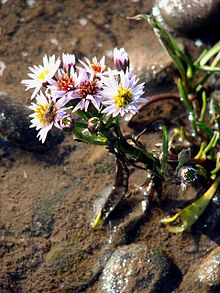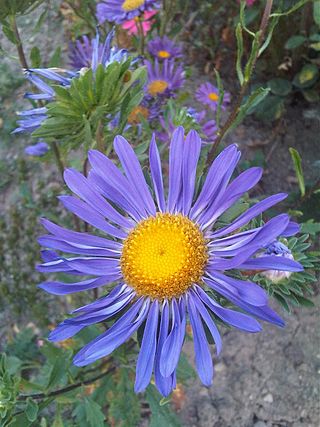
Callistephus is a monotypic genus of flowering plants in the aster family, Asteraceae, containing the single species Callistephus chinensis. Its common names include China aster and annual aster. It is native to China and Korea. and it is cultivated worldwide as an ornamental plant in cottage gardens and as a cut flower.
Lasthenia glaberrima is a species of flowering plant in the family Asteraceae known by the common names smooth goldfields and rayless goldfields. It is native to western North America from British Columbia to California, where it grows in wet meadows and vernal pools.

Symphyotrichum sericeum is a species of flowering plant in the family Asteraceae native to central North America. Commonly known as western silver aster, western silvery aster, and silky aster, it is a perennial, herbaceous plant that may reach 70 centimeters tall. Its flowers have purple ray florets and pink then purple disk florets, and its leaves are firm and silvery-green.

Symphyotrichum frondosum is a species of flowering plant in the family Asteraceae native to western North America. Commonly known as short-rayed alkali aster, it is an annual or perennial herbaceous plant that may reach 140 centimeters tall.

Symphyotrichum lentum is a species of flowering plant in the family Asteraceae with the common name of Suisun Marsh aster. It is a perennial and herbaceous plant endemic to the marshes of Sacramento-San Joaquin River Delta of Northern California.

Doellingeria is a genus of flowering plants in the family Asteraceae. It contains species formerly included in Aster but now considered to be a distinct genus. They are known commonly as tall flat-topped asters or whitetops.
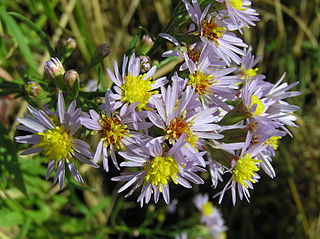
Tripolium is a genus of Eurasian and North African plants in the tribe Astereae within the family Asteraceae.

Senecio aphanactis, known by the common names chaparral ragwort, rayless ragwort, and California groundsel, is a species of flowering plant in the aster family.
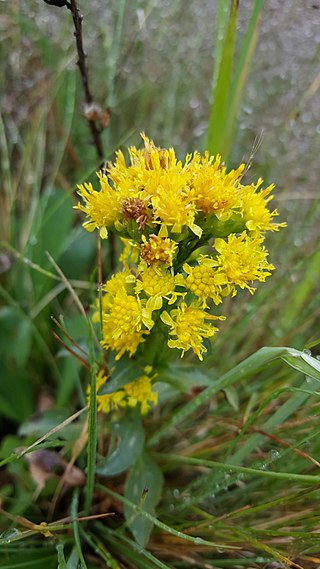
Senecio aronicoides is a species of flowering plant in the aster family known by the common name rayless ragwort. It is native to Oregon and northern and central California, where it can be found in the woodlands and forests of mountains and foothills, often in relatively dry habitat. It is a biennial or perennial herb growing up to about 90 centimeters tall from a fleshy root attached to a buttonlike caudex. The plant is often slightly woolly or cobwebby in texture. The leaves have lance-shaped to oval blades measuring up to 20 centimeters long, the largest ones lower on the stem. The inflorescence is a corymb which is flat and spreading, often resembling an umbel. The flower heads are cups lined with black- or green-tipped phyllaries and filled with many gold disc florets. There are usually no ray florets but one or two occasionally emerge from a head. The fruit is a hairless achene tipped with a pappus of long, white bristles.
Packera indecora is a species of flowering plant in the aster family known by the common names elegant groundsel and rayless mountain ragwort. It is native to northern North America including most of Canada and sections of the northernmost United States. It grows in moist mountain habitat, such as streamsides and meadows.

Senecio sylvaticus is a species of flowering plant in the aster family. It is variously known as the woodland ragwort, heath groundsel, or mountain common groundsel. It is native to Eurasia, and it can be found in other places, including western and eastern sections of North America, as an introduced species and an occasional roadside weed. It grows best in cool, wet areas. It is an annual herb producing a single erect stem up to 80 centimeters tall from a taproot. It is coated in short, curly hairs. The toothed, deeply lobed leaves are up to 12 centimeters long and borne on petioles. They are evenly distributed along the stem. The inflorescence is a wide, spreading array of many flower heads, each lined with green- or black-tipped phyllaries. The heads contain yellow disc florets and most have very tiny yellow ray florets as well.
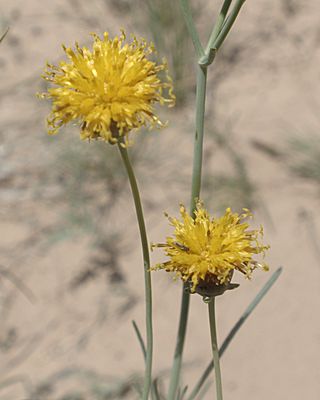
Thelesperma megapotamicum is a perennial species of flowering plant in the aster family known by the common name wild tea and rayless greenthread. It is native to sections of the Americas, including the central United States, where it grows in many types of habitat.

Galatella sedifolia, often known by the synonym Aster sedifolius, is herbaceous perennial plant belonging to the genus Galatella of the family Asteraceae.

Symphyotrichum prenanthoides is a species of flowering plant in the family Asteraceae known by the common name crookedstem aster. It is native to northcentral and northeastern North America.
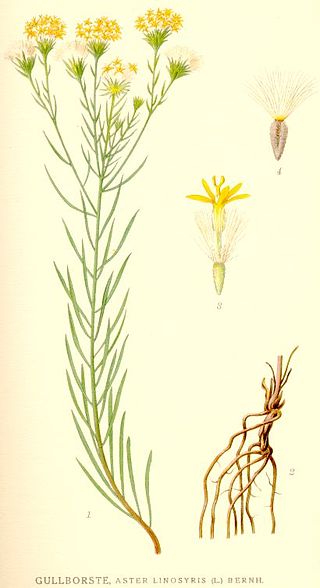
Galatella linosyris is a species of perennial plant from family Asteraceae found in Eastern, Central and Southern Europe. It can also be found in Great Britain, the southern part of Scandinavia and in Asia Minor. The flowers are yellow coloured. The species have stems up to 10–50 centimetres (3.9–19.7 in), with leaves that are lanceolate. The plant does not have ray flowers, only disk florets. It blooms from July to September. The fruits are achenes. The species is under protection in the Czech Republic.

Dittrichia graveolens, commonly known as stinkwort or stinking fleabane, is a plant species in the sunflower family, native to southern Europe, North Africa, and western Asia as far east as Pakistan. It has become naturalized in California, Asia, Africa, Australia, and other places and is regarded as a noxious weed in some regions. It is a classified as an invasive species in California, and a potential threat to wine production in the state.

Bigelowia nuttallii is a species of North American flowering plants in the family Asteraceae, native to the southern United States.
Bigelowia nudata, the pineland rayless goldenrod, is a species of North American flowering plant in the family Asteraceae. It is native to the coastal plain of the southeastern United States.

Ericameria resinosa, the Columbia goldenweed, or Columbia goldenbush, is a North American species of flowering shrubs in the family Asteraceae. It is native to the northwestern part of the United States, in the states of Washington, Oregon, and Idaho.

Eucephalus tomentellus is a North American species of flowering plant in the family Asteraceae known by the common name Brickellbush aster or rayless aster. It grows on openings in oak or conifer forests the Siskiyou Mountains of the US States of California and Oregon.
